Snapshot: Introduction to the life cycle of cultivated maize, from seed germination to harvest.
Topics covered on this page: Introduction; Germination and vegetative growth; Seed germination; Post-germination vegetative growth; Reproductive structures, pollination, and fertilization; Development of the tassel; Development of the ears; Pollen release; Silking; Pollination and fertilization; Fruit maturation (grain filling); Resources.
Credits: Funded by the National Science Foundation. Any opinions, findings, and conclusions or recommendations expressed in this material are those of the author(s) and do not necessarily reflect the views of the National Science Foundation. The text on this page primarily comes from content prepared for a revised manuscript of the Teacher-Friendly Guide to the Evolution Maize (Carlyn Buckler, Dhyan Palanichamy, and Andrielle Swaby, 2019). Additional text and revisions by Elizabeth J. Hermsen (2023).
Updates: Page last updated March 13, 2023.
Image above: Tassels (groups of male florets) and ears (groups of female florets) of maize (Zea mays) plants growing in a field in the Philippines, 2021. Left photo and right photo by JFVelasquez Floro (Wikimedia Commons, Creative Commons CC0 1.0 Universal/public domain dedication).
Introduction
Maize (Zea mays) is grown from seed in cultivated fields as an annual crop. The process of maize development begins with a seed planted in the soil and ends with a plant that is taller than most people. This progression includes all the changes the plant undergoes, from seed germination through vegetative growth, flowering, and seed formation. This page will go through the growth and development of a maize plant cultivated for grain, from germination to harvest.

Diagram of a mature maize (Zea mays) plant. Diagram by LadyofHats (Wikimedia Commons, CC0 1.0 Universal/public domain dedication, image relabeled).
Germination and vegetative growth
Seed germination
Development of the maize plant begins in the embryo, which uses energy stored in the endosperm to fuel its growth. As the seed absorbs moisture, it absorbs up 30-35% of its weight in water and increases in size.
Seed germination—the initiation of the growth process after the embryo has developed—is the first step in maize growth. A maize seed needs soil temperatures of at least 50°F (10°C) and the right amount of moisture in order to germinate. Maize germinates more quickly at warmer temperatures. The optimal temperature for maize germination is 75°F (24°C). At 75°F, it takes only four days for maize seedlings to emerge; at 50°F, seedlings take a little over a month to emerge. Very high temperatures, however, can cause seedlings to desiccate (dry out).
The radicle (primary root) grows first, splitting the seed coat. This takes two or three days at optimal temperature. A few days after the radicle has emerged, the coleoptile—a sheath that protects the embryonic shoot—grows upward. Is is pushed through the soil by elongation of the mesocotyl. Seminal roots (roots that develop on the embryo above the radicle) emerge from the kernel.
The coleoptile eventually emerges from the soil, after which the first leaf splits the coleoptile and expands. The nodal roots (roots that develop on the nodes of the maize stalk) begin to grow soon after this point.
Video showing the germination of a sweet corn (Zea mays) seed underground. The coleoptile is the first structure to emerge, followed by the primary root. Note: This video has background music, but no narration. Credit: "Sweet corn underground germination time lapse" by Neil Bromhall (via YouTube).
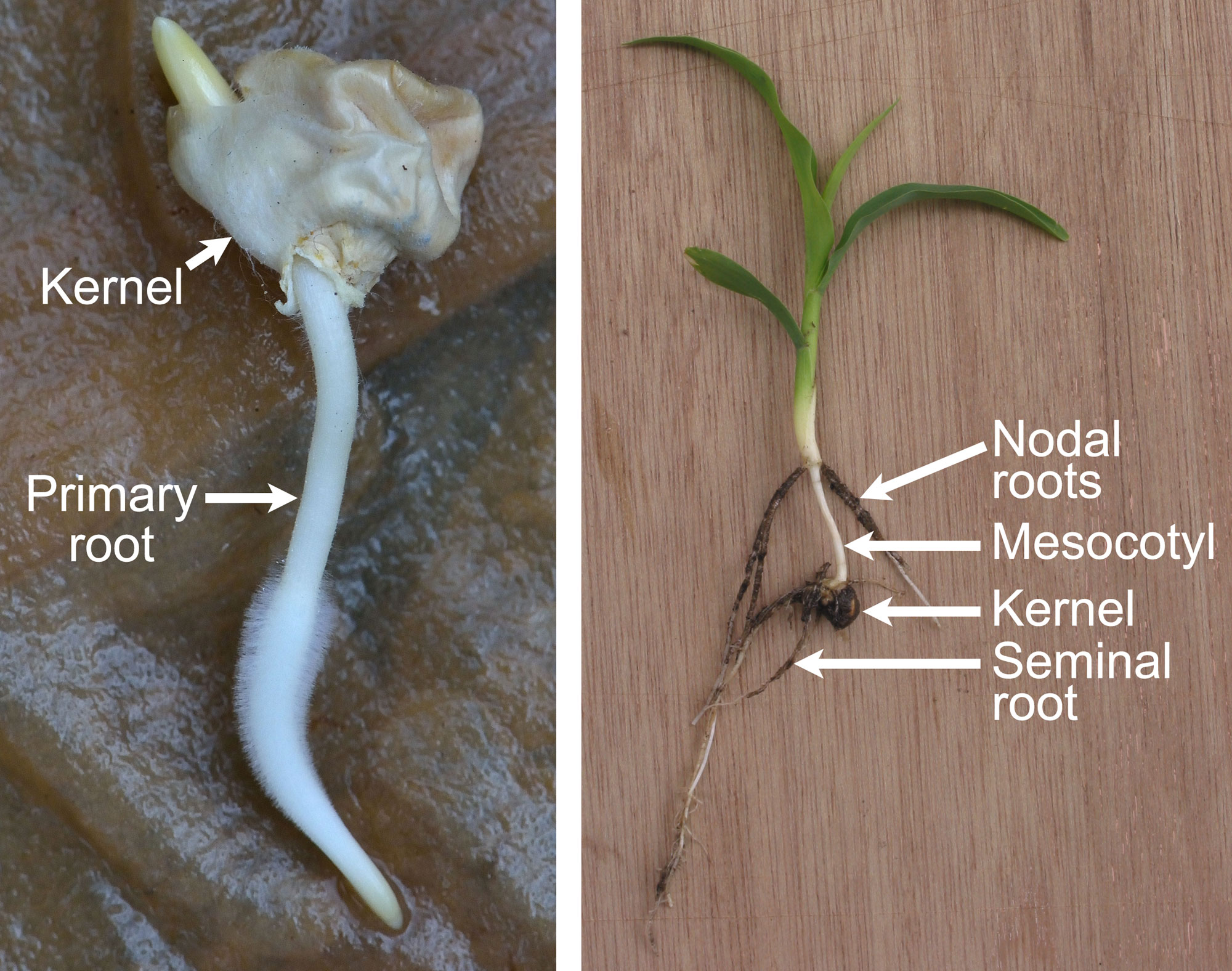
Germinated kernels (grains or caryopses) of maize (Zea mays). Left: A germinated kernel with a primary root bearing root hairs protruding from its lower side; a bit of a the coleoptile (shoot sheath) is extending from its upper side. Right: Seedling of maize bearing seminal roots and first nodal roots separated by an extended mesocotyl (a transition region between the primary root and the aboveground parts of the plant). The first nodal roots will remain completely underground. Left photo and right photo by Rasbak (Wikimedia Commons, Creative Commons Attribution-ShareAlike 3.0 Unported license, images cropped, left image resized, labels added).
Post-germination vegetative growth
Once a grass emerges above the soil, it enters the vegetative growth stage, which includes all of the plant’s growth between germination and flowering. In maize, this phase includes growth of the plant's leaves, roots, and stems, but not the tassels or ears.
As in other plants, maize growth occurs through cell divisions that occur in regions called meristems. Meristems that add length to shoots and roots can found at the shoot and root tips. The meristem at the tip of a shoot adds new cells to the stem and is also the region where new leaves begin to form, thus establishing the pattern of leaves on the stem.
Under the right conditions, new maize leaves appear every three to four days. By the time the plant is four or five weeks old, all leaves that will develop are present, although some of them will still be tiny and not fully formed. There can be 18 to 21 total leaves on a maize plant. New leaves stop forming when the reproductive structures begin to develop.
As leaves and reproductive structures develop (see below), stem growth continues to occur in the stem internodes (the regions of the stem between the leaves). This continued growth rapidly increases the height of the plant.

A field of young maize plants. Photo by in de_ja_re (flickr, Creative Commons Attribution-ShareAlike 2.0 Generic license, image cropped and resized).

A field of young maize plants. Photo by in hiatus (flickr, Creative Commons Attribution 2.0 Generic license, image resized).

A field of young maize plants. Photo by Tim Green (flickr, Creative Commons Attribution 2.0 Generic license, image cropped and resized).
Reproductive structures, pollination, and fertilization
Development of the tassel
Reproductive development is the process of flower growth and development, and, following pollination and fertilization, fruit and seed development. After the maize plant is a few weeks old, the growing tip of the stem transitions from leaf production to tassel development. One branched tassel bearing many male spikelets, each with two male florets (tiny flowers), will develop at the end of the stem. At the beginning of this stage, reproductive structures are not visible on the outside of the plant.
The tassel emerges when the maize is about four to five weeks old. It can take 26 to 30 days to develop to full size. After the tassel emerges, maize diverts its energy to reproduction, and the plant’s vegetative growth rate slows.
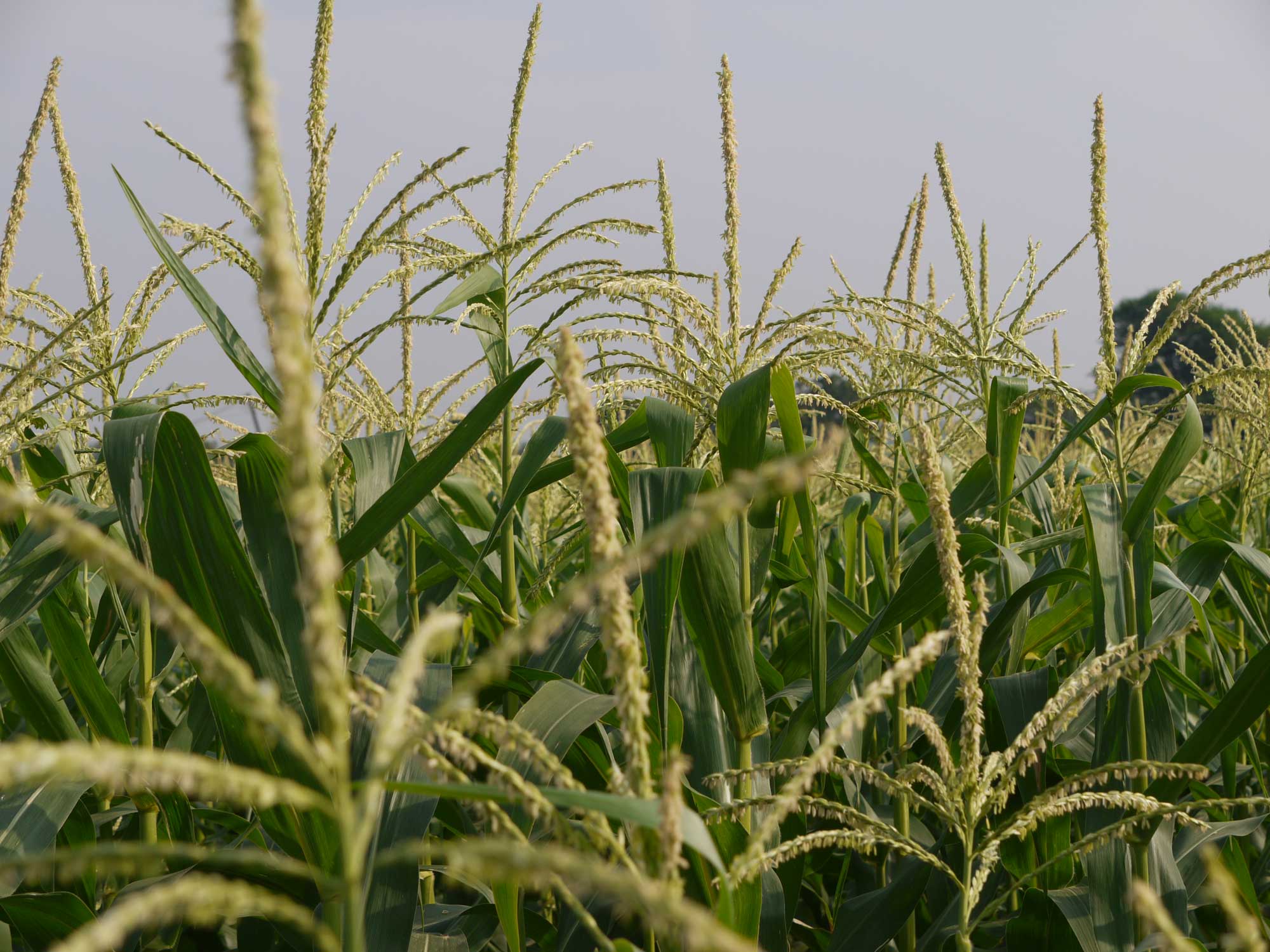
Tassels of maize (Zea mays). Photo by Dinesh Valke (flickr, Creative Commons Attribution-ShareAlike 2.0 Generic license, image resized).
Development of the ears
At the same time as the tassel begin to develop, axillary buds (buds that form in the upper angle between a leaf and the stem) at the nodes begin forming the ears, or the inflorescences that bear female florets (these florets eventually develop into kernels). Each axillary bud is essentially a tiny branch with its own shoot apical meristem. Each bud forms a short lateral (side) branch off the main stem of the maize plant; an ear develops at the end of each side branch. Each ear is surrounded at its base by a husk made up of a series of modified leaves. The cob, or the central axis of the corn ear, is a modified stem.
The number of female spikelets, each containing a single fertile female floret, in an ear is determined when the ear starts to develop. Ears grow larger in response to good light and better nitrogen levels, and new spikelets are added to the tip of the ear in response to these favorable conditions.
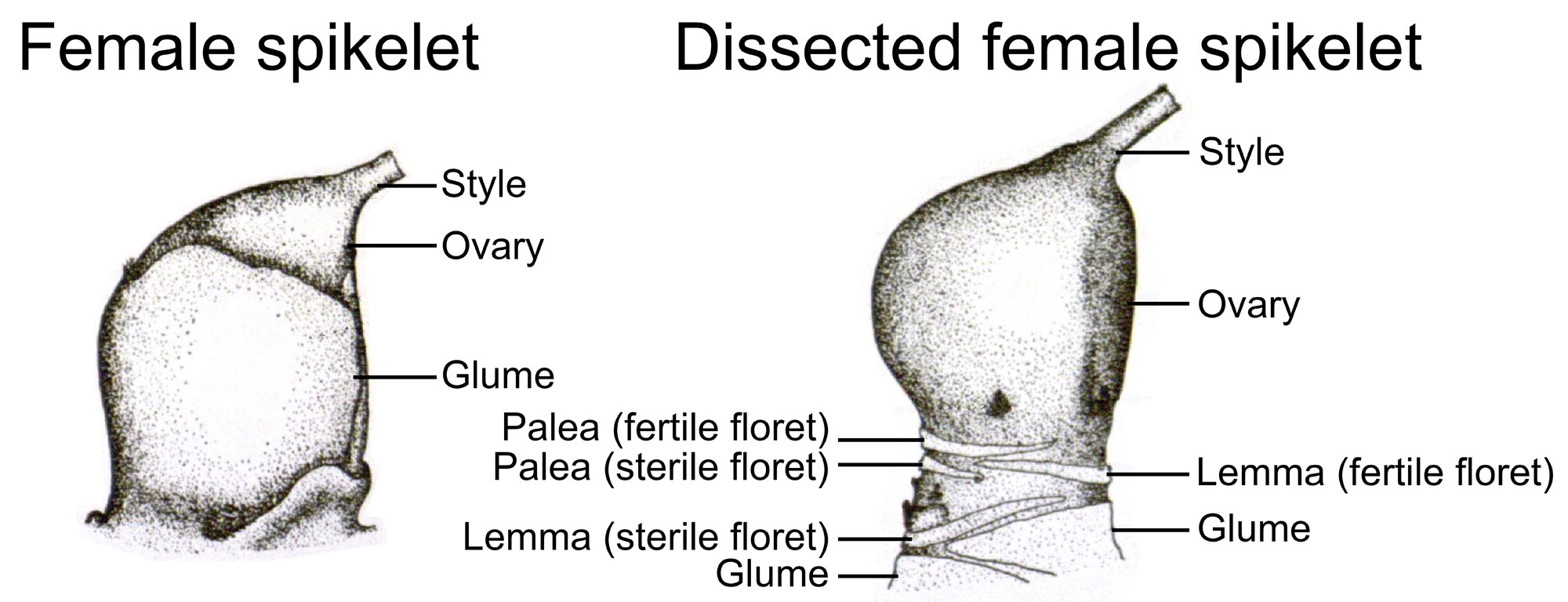
Diagrams of a maize female (pistillate or carpellate) spikelet, each with one fertile floret. Left: Female spikelet with the bracts attached. Notice that the glumes cover much of the ovary. The style and stigma are very long, so they have been cut off in the image. Right: A dissected female spikelet. Note that the bracts (glumes, lemmas, and paleas) have been removed, leaving only their bases. The style and stigma are very long, so they have been cut off in the image. Source: Plate 5, figs. 3 and 4 from Weatherwax (1916) Bulletin of the Torrey Botanical Club 43: 127-144 (Biodiversity Heritage Library, public domain).
Pollen release
As the tassels reach maturity, the stamens emerge from the male florets, and their anthers release pollen grains into the air. Between 2 and 25 million yellow-white pollen grains are produced from each tassel and are dispersed from pores that open at the tips of the anthers.
Like many other grasses, maize is wind-pollinated. Therefore, its pollen grains are tiny and light; they are about 100 microns, or about 1/10 of a millimeter, in diameter. Despite this, maize pollen is heavy enough it cannot travel very far in the air. Although maize pollen can travel as far as half a mile under wind conditions of about 15 miles per hour (about 24 kilometers per hour), most pollen grains will land within 20 to 50 feet (about 6 to 15 meters) of the parent plant.
Pollen is shed from a single plant over a period of several days. Due to natural variations between plants, it make take as long as two weeks for an entire field of maize to complete shedding its pollen. Pollen production and shedding can be influenced by weather conditions, with less pollen being shed during wet conditions and more being shed during warm and dry conditions. Maize pollen dehydrates easily and is especially susceptible to high temperatures and drought. Extreme heat stress, with temperatures in excess of 100°F (38°C), will desiccate and kill the pollen grains.

Diagrams of a maize male (staminate) spikelet and male (staminate) floret. Left: Male spikelet with two florets, one of which is open with stamens protruding. Note that the lemmas are not labeled because they are under the glumes, and thus not visible in the drawing. Right: A single dissected male floret. Note that the palea is not labeled because it has been removed to expose the stamens. Source: Plate 5, figs. 1 and 2 from Weatherwax (1916) Bulletin of the Torrey Botanical Club 43: 127-144 (Biodiversity Heritage Library, public domain).
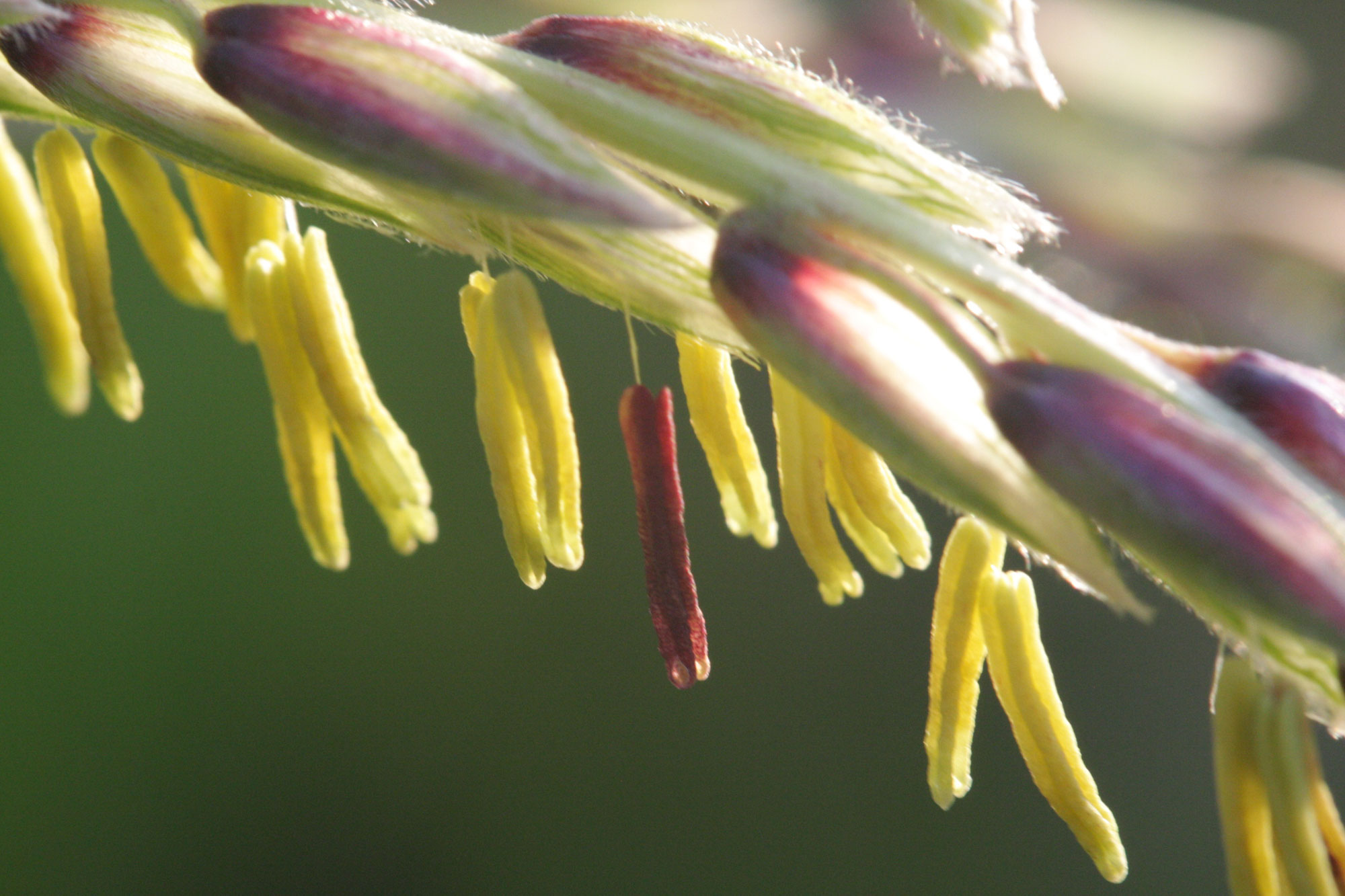
Male florets of maize with anthers hanging out of them, which allows pollen to be carried away by the wind once it is released. Photo by Henry Mühlpfordt (Wikimedia Commons, Creative Commons Attribution-ShareAlike 3.0 Unported license, image resized).

Scanning electron micrographs (photos taken with a scanning electron microscope, or SEM) of maize pollen in two views (other types of smaller pollen grains can be seen in the background). Left photo and right photo by Louisa Howard, Dartmouth College EM Facility (Cell Image Library, public domain).
Silking
A few days after the tassel begins to shed pollen, the ear begins silking or producing silk. The silks are the stigmas (pollen-receiving structures) of the female maize florets. Silks elongate from each floret on the cob over a period of three to five days. Water is absorbed from the cob and used to push the silk forward along the inside of the husk until it reaches the open tip. Silks at the bottom of the cob begin elongating before silks at the top of the cob, reducing the potential for “traffic jams.”
Each silk will continue to elongate until it is pollinated or until it dehydrates, which usually happens about ten days after a silk emerges. When silks first emerge, they can lengthen as much as 1.5 inches (4 centimeters) every day, but elongation slows over time. The silks are sticky to help capture pollen grains.
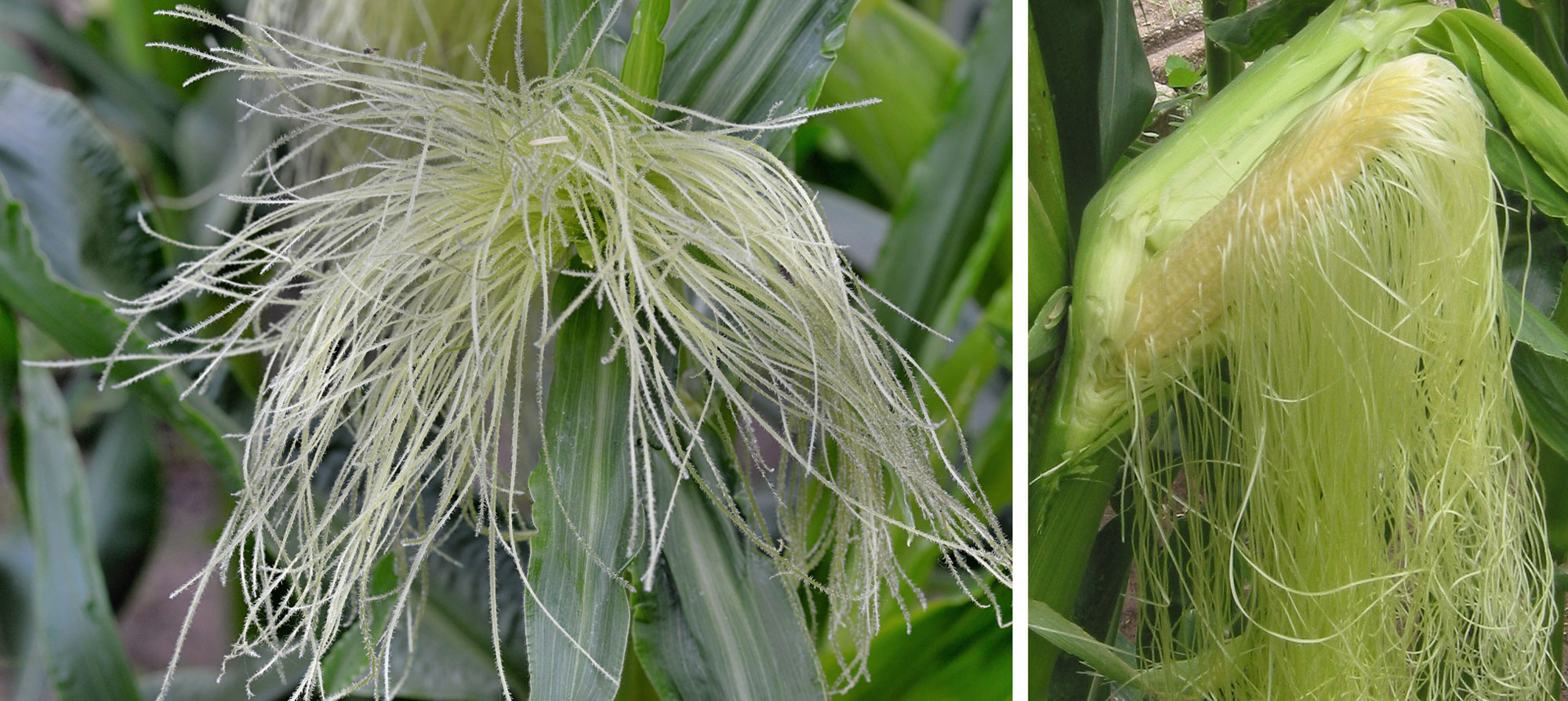
Maize silk (stigmas). Left: Silks, showing the minute hairs on the silks. Right: An ear of corn with the husk opened showing the silks dangling from each female floret. Left photo and right photo by Rasbak (Wikimedia Commons, Creative Commons Attribution-ShareAlike 3.0 Unported license, image cropped and resized).
Pollination and fertilization
Maize is primarily cross-pollinated, meaning that pollen from one plant is carried by wind to other maize plants, where it lands on their silks.
Each silk can accept one pollen grain. The pollen grain germinates, producing a pollen tube, which grows down the silk to the ovary. The silk can be over 12 inches (about 30.5 centimeters) long in some maize varieties. The pollen tube growth process can take up to 24 hours, depending on the length of the silk and where on the silk the pollen grain landed. Once the pollen tube reaches the egg in the ovary, the egg is fertilized. After fertilization, the silk withers and becomes brown.
After pollination and fertilization, the ovary will mature into a kernel, with the ovary wall becoming the kernel’s outer coat. Pollination and fertilization are critical to maize yield. Poor conditions such as drought and heat can disrupt these processes, as they can delay silking or cause the silk to dry out or not grow as long. Poorly pollinated maize will not develop kernels.
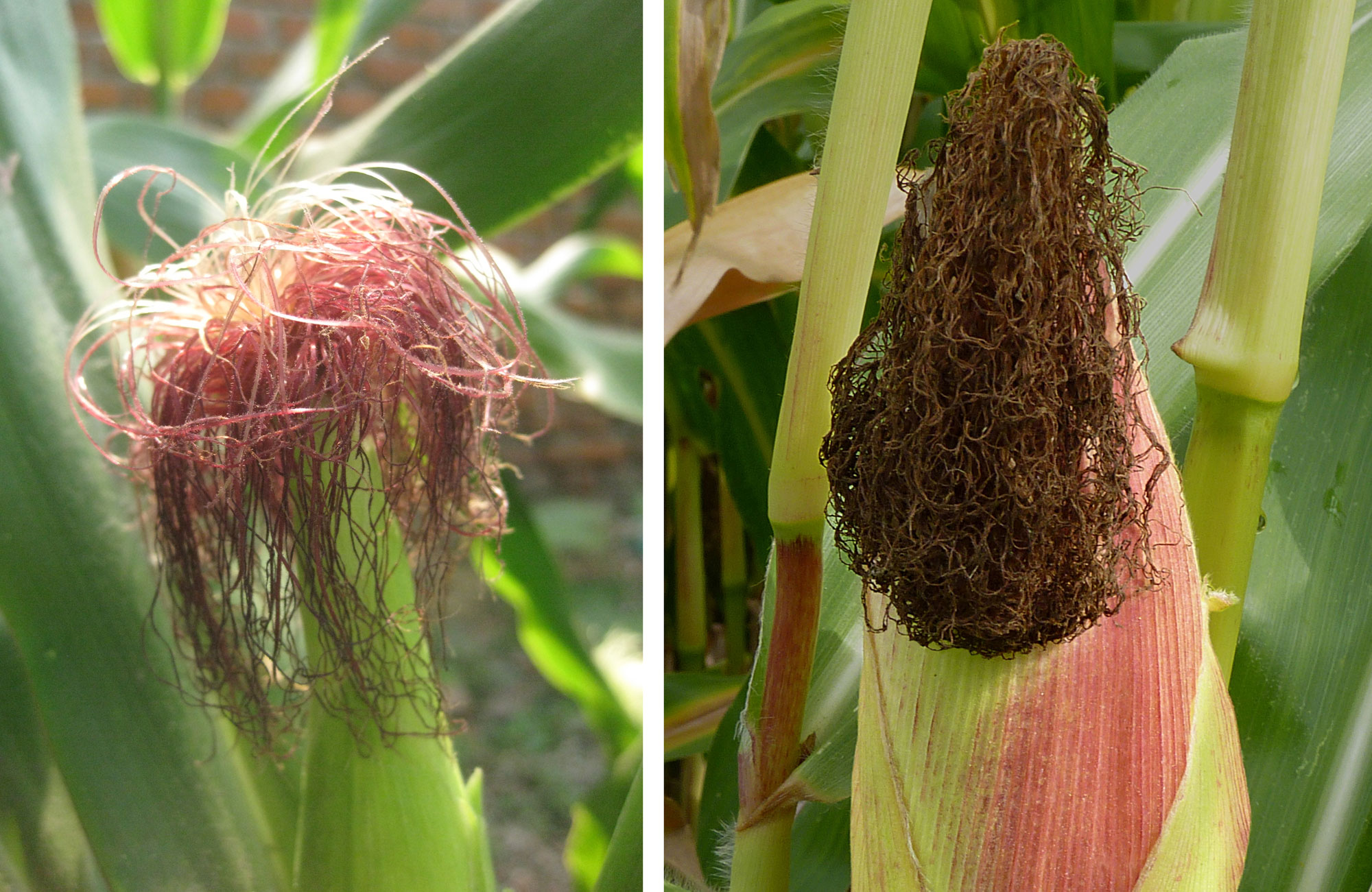
Ears of maize with partially (left) and fully (right) withered silks. Left photo by Jalyton (Wikimedia Commons, CC0 1.0 Universal/public domain dedication), right photo by Jamain (Wikimedia Commons, Creative Commons Attribution-ShareAlike 3.0 Unported license) images cropped and resized.
Fruit maturation (grain filling)
After fertilization, maize kernels go through a series of developmental changes in which they deepen in color, accumulate starch, and change in moisture content. At maturity, each kernel contains an embryo, food for the embryo (endosperm), one embryonic leaf (a cotyledon or scutellum), and an outer protective layer called the pericarp or fruit wall. The different colors found in maize are due to the varying colors of the outer layer of the endosperm, called the aleurone layer; there are at least 50 different types of kernel patterns and colors among different varieties of maize. The inside of the kernel, however, is always yellow.
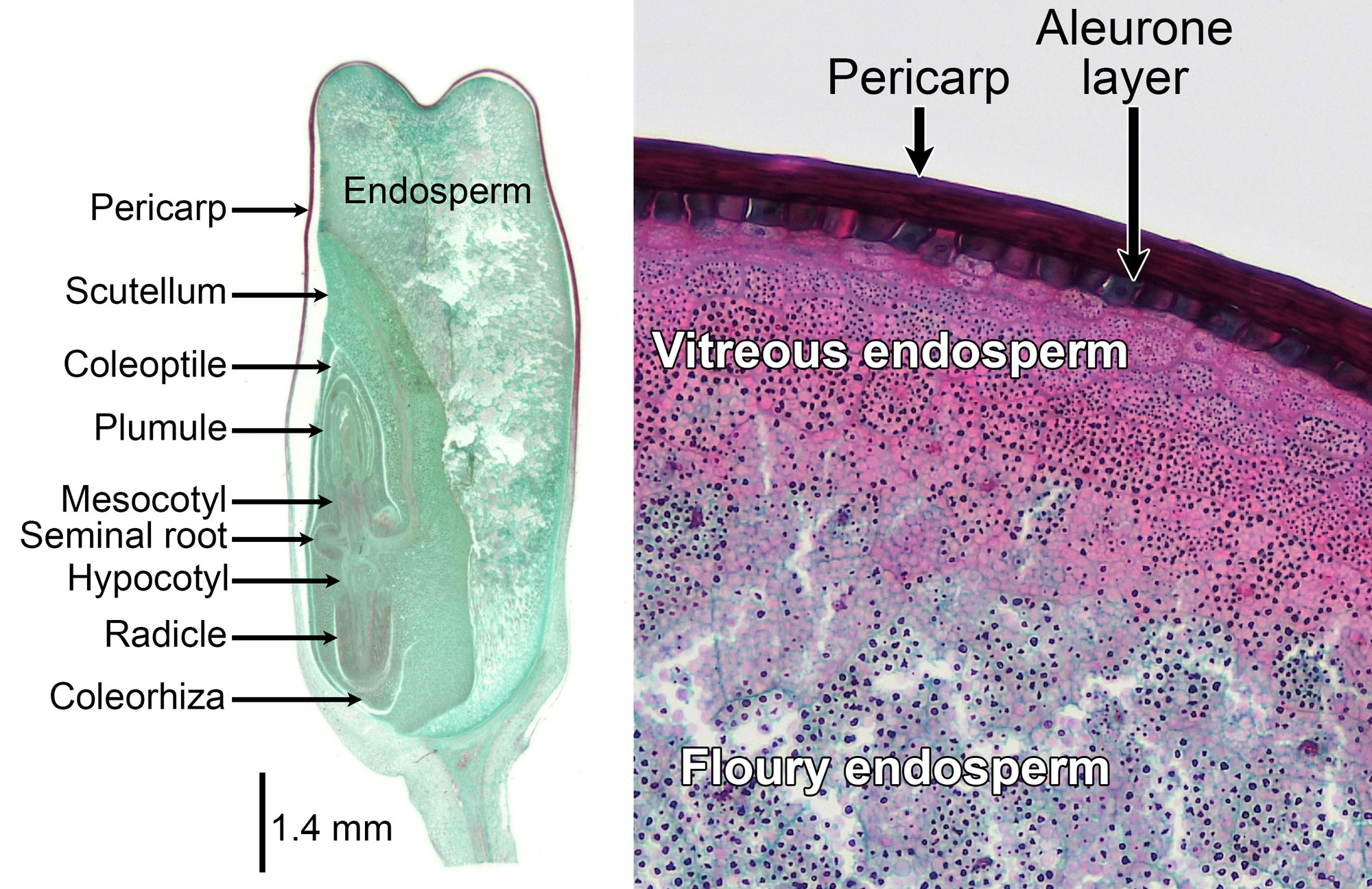
Caryopsis (grain) of maize (Zea mays). Left: Longitudinal section of a mature grain or caryopsis, also called a kernel. Right: Detail of a maize caryopsis showing the pericarp (fruit wall), aleurone layer, and endosperm. Maize has both hard endosperm (called horny endosperm) and soft endosperm (called floury endosperm). Left photo by Jon Houseman and Matthew Ford (Wikimedia Commons, Creative Commons Attribution-ShareAlike 4.0 International license). Right photo by Conor Fitzgerald, 2019 (Berkshire Community College Bioscience Image Library on flickr, public domain). Images cropped, resized, and labeled.
The developmental stages that maize kernels pass through are as the follows:
Blister Stage: Approximately 10 to 12 days after silking, fertilized ovules are the shape of a tiny blister. These kernels are ivory white. They begin to expand as their liquid content increases; blister kernels have about 85% moisture content. The maize cob can be seen in between the rows of tiny kernels.
Milk Stage: Three weeks after fertilization, the kernel interior has filled with milky juices and the outside of the kernel has turned yellow. Starch begins to accumulate within the kernel. This stage has the highest sugar content. This is the stage at which sweet corn is harvested.
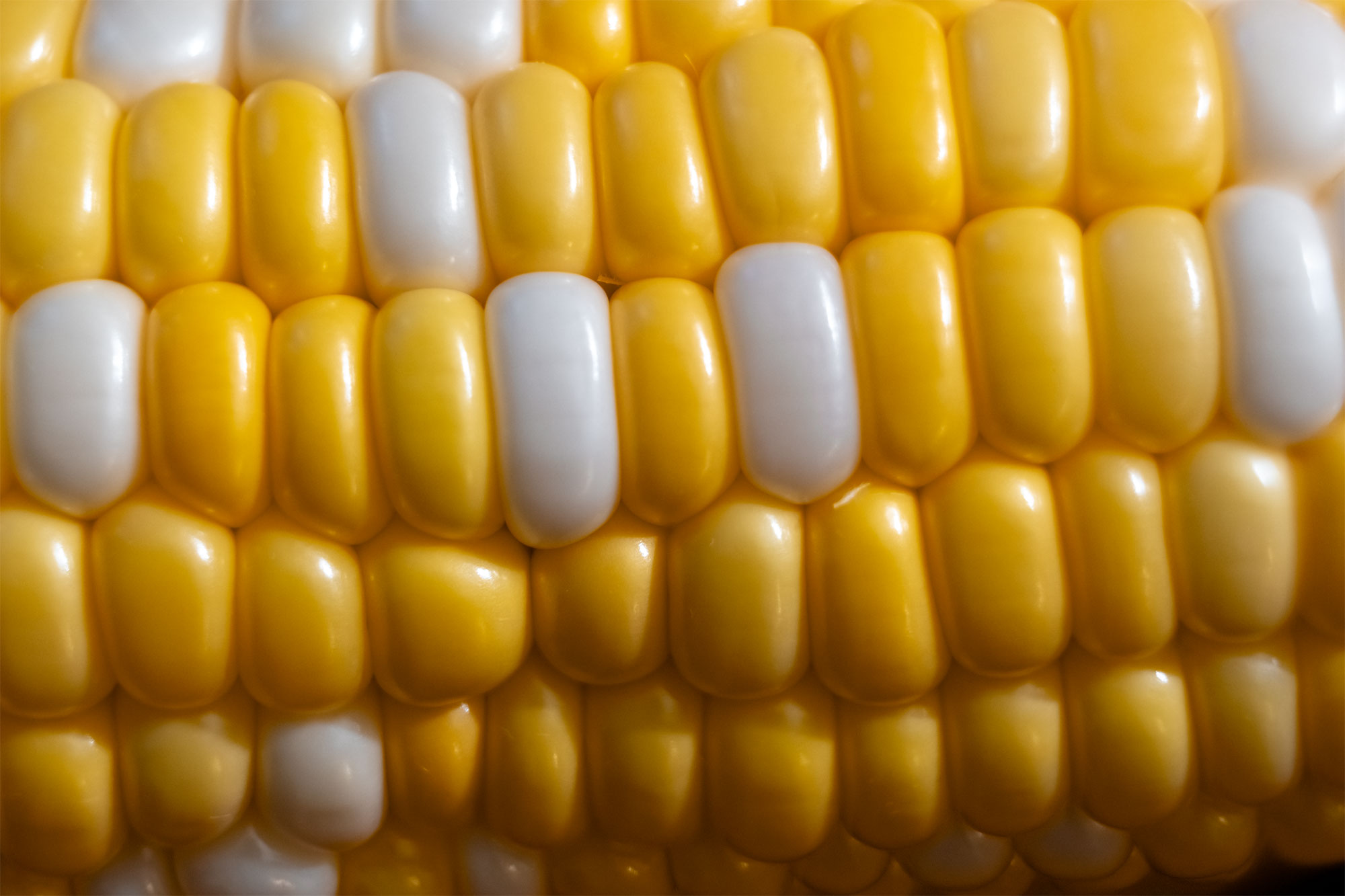
Sweet corn kernels. Photo by WetMethanol (Wikimedia Commons, Creative Commons Attribution-ShareAlike 4.0 International license, image resized).
Dough Stage: Around a month after fertilization, sugars from the milk stage have been converted to starch, and kernel moisture decreases. The interior of the kernel now has a consistency similar to dough. The outside of the kernel becomes a deep yellow, while the inside remains white. The top of the kernel begins to flatten as moisture is lost and starch increases.
Dent Stage: By about 33 days after fertilization, the moisture level in each kernel has decreased enough that a dent appears in the top of each kernel. Starch continues to accumulate within the kernel, solidifying at the top.
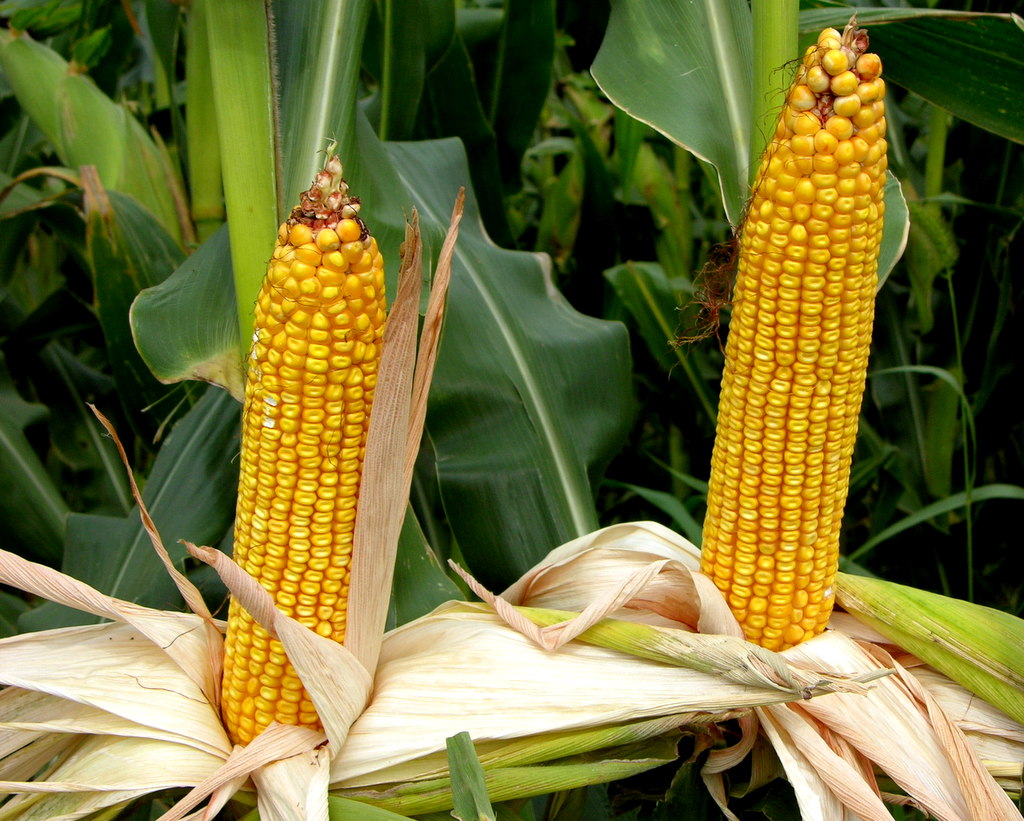
Ears of maize (Zea mays) with dent kernels, Missouri, U.S.A. The kernels on the ears above are probably past the dent stage. "Corn ears," photo by Phil Warren (flickr, Creative Commons Attribution 2.0 Generic license).
Physiological maturity (black layer stage): A little over two months after fertilization, the kernels reach physiological maturity; each embryo is fully developed and starch storage is complete. The kernels have become a dark yellow and have a moisture content of only about 35%. A dark layer of tissue forms at the base of the kernel, blocking further growth.
After maize ears reach physiological maturity, they are ready to be harvested. Farmers can leave the maize in the field to dry, or can artificially dry it indoors. The optimal moisture content of maize grains for storage is 13% to 15%; maize is generally sold at around 14% moisture. By the time of harvest, the whole maize plant has dried up and turned brown. Under the right conditions, maize kernels can remain viable for as long as a decade, breaking dormancy when conditions are right for germination.
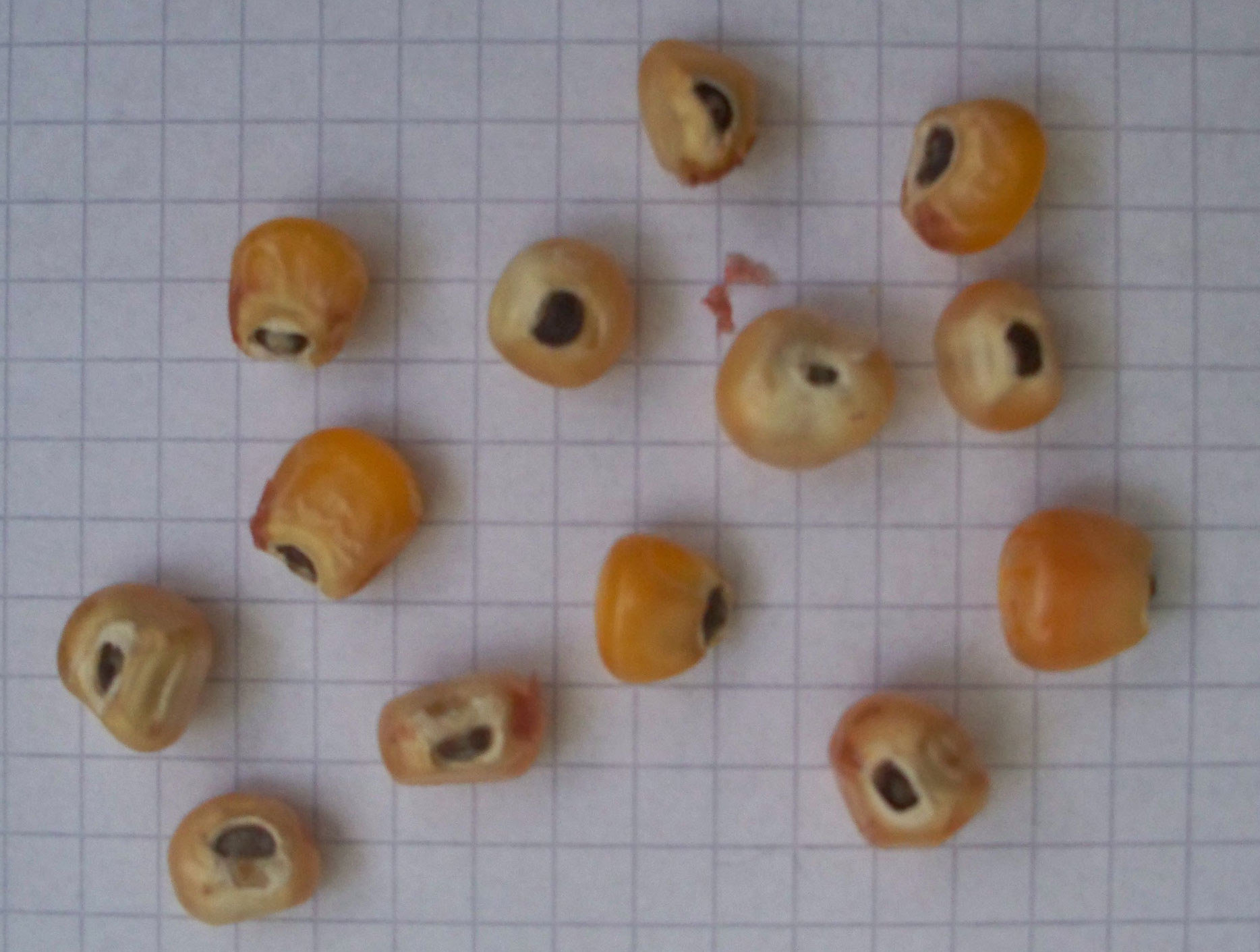
Maize kernels at physiological maturity showing the black layer of tissue at the base of the kernels. Photo by Agronom (Wikimedia Commons, Creative Commons Attribution-ShareAlike 3.0 Unported license, image cropped).
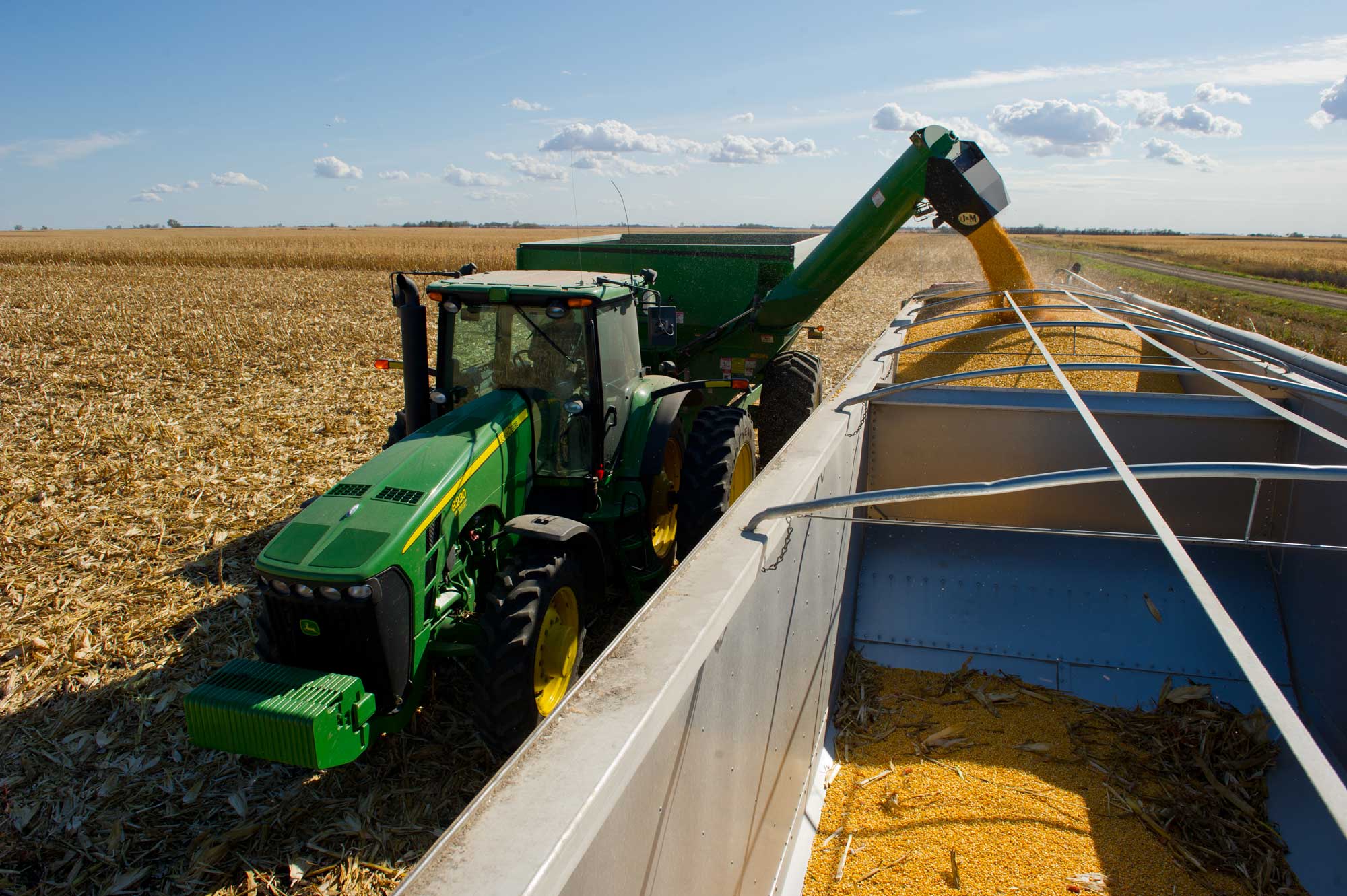
Maize harvest. Photo by United Soybean Board (flickr, Creative Commons Attribution 2.0 license, image resized).
Resources
Websites
Additional resources from the Paleontological Research Institution
Earth@Home: Evolution: Grass life cycle and reproduction: https://evolution.earthathome.org/grasses/life-cycle/
Earth@Home: Evolution: Maize morphology and anatomy: https://evolution.earthathome.org/grasses/andropogoneae/maize-morphology/
Articles and books
Edwards, J.. 2009. Maize growth & development. State of New South Wales, Australia. PDF: https://www.dpi.nsw.gov.au/__data/assets/pdf_file/0007/516184/Procrop-maize-growth-and-development.pdf
Nielson, R. L. (B.) 1996, revised 2007. Ear size determination in corn. Corny News Network, June 2007. https://www.agry.purdue.edu/ext/corn/news/timeless/earsize.html
Nielson, R. L. (B.) 2021. Grain fill stages in corn. Corny News Network, August 2021. https://www.agry.purdue.edu/ext/corn/news/timeless/grainfill.html
Scientific articles and books
Weatherwax, P. 1916. Morphology of the flowers of Zea mays. Bulletin of the Torrey Botanical Club 43: 127-144. https://doi.org/10.2307/2479625



